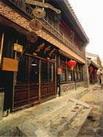1) the coloured glaze stoves


琉璃窑厂
1.
This article discusses the time of the coloured glaze stoves that moved out of the area of the Southern Xuanwumen, the source of “Annotate of Fuchuzhai poetry anthology” written by Weng Fanggang, and the function for managing the imgrants from other provinces by the guild hal.
本文讨论了琉璃窑厂迁出宣南的年代、后人征引的所谓翁方纲《复初斋诗注》的出处、明代北京会馆的外来人口管理职能与内外城会馆功能的地域差异,对相关问题做了初步辨析。
2) Liu Lichang


琉璃厂
1.
In Beijing , the public center of the modern newspapers and periodicals was in Xuan Nan district,especially in the Liu Lichang area.
北京近代报刊的发行中心在宣南地区 ,尤其是以琉璃厂为中心的区域。
3) colored glaze product plant


琉璃制品厂
4) coloured glaze


琉璃
1.
The paper mainly discusses the technologies of making ceramics, bricks and tiles, coloured glaze, together with their characteristics and application based on some historical materials and unearthed artifacts of the Hsi Hsia Kingdom.
本文以有关史料和出土文物为依据,对西夏的陶瓷砖瓦琉璃制造技术、产品特点及应用进行了探
2.
The word liuli does not mean irregular, but was the first loan word in the history of Chinese - a transliteration of liuli, coloured glaze.
此“陆离”非参差之意,而是屈原留下来的夏言史和汉语史上的第一个外来语——“琉璃”的音译。
5) Beijing Liulichɑng Shudiɑnjie


北京琉璃厂书店街
6) glazed roof tile


琉璃瓦
1.
Study on glazed roof tile made from red mud;


利用赤泥制备琉璃瓦的研究
2.
In this study,biscuit for glazed roof tile was prepared using red mud and other raw materials,the bending strength of which was 29.
3MPa琉璃瓦素坯,开发出与该坯体烧结温度一致的无铅琉璃瓦用釉,并采用一次烧成工艺制备出了达到国家建筑琉璃制品标准GB9197-88要求,及国家建材行业建筑琉璃制品标准JC/T765-2006要求的无铅琉璃瓦。
补充资料:琉璃厂文化街

琉璃厂文化街
琉璃厂在宣武区和平门外,辽时为“海王村”。元明时曾设琉璃窑厂,因有"琉璃厂"之称。
清初古董商开始在此经营,乾隆时(1736-1795)已成为古玩字画、古籍碑帖及文房四宝的集散地。建国后这里更富有文化街的特色。驰名中外的荣宝斋及中国书店和文物商店的许多门市部如文奎堂、邃雅斋、宝古斋、庆云堂等先后在此设立。过去,书家、名士如何绍基、陆润库、康有为、华世奎、翁同龢、梁启超、沈尹默等都曾为书铺、文物店题写牌匾,后又有当代书家为革文阁、悦雅堂、恰肪斋、振寰阁、韫玉斋等商店题匾。名人书写的牌匾给人以文苑意境的清雅古朴之感。
1982年琉璃厂文化街整修重建。新建后的街道全长750米,东至延寿寺街,西至南北柳巷,中为南新华街。街道两旁,铺面店堂青砖灰瓦,砖雕彩绘古色古香,更具有浓厚的古代街市色彩。古董 荣宝斋
说明:补充资料仅用于学习参考,请勿用于其它任何用途。